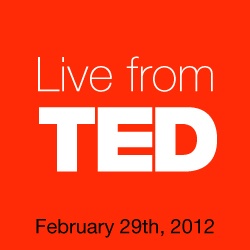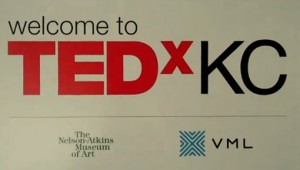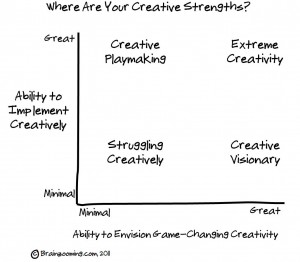With a theme of “Full Spectrum,” maybe it should not be a surprise the 2012 TED Simulcast featured an odd range of content quality. There was a valuable session on extreme creativity (“Session 6 – The Crowd”), an intriguing session on amazing innovation (“Session 4 - The Lab”), and an important 2012 TED session that was a disappointing mess (“Session 5 - The Earth”). After sitting through a long day of 2012 TED Simulcast presentations at Kansas City’s Nelson Atkins museum (and enduring the perennial poor food service planning plus getting booted from my original seat because someone decided we shouldn’t be creating online content from the 2012 TED simulcast), I didn’t even stick around for the day’s final session, “The City.”
Rather than profiling highlights of each "Full Spectrum" session as in previous TED and TEDxKC recaps, here are eight takeaways that apply to extreme creativity and amazing innovation from across the various "Full Spectrum" 2012 TED Simulcast talks:
1. If you create your own brand new world, do you, by definition, become a child again in that new world – a child without fear?
Regina Dugan, director of DARPA (whose mission is “the prevention of strategic surprise”) spoke about fear of failure constraining us. You can’t both fear failure and create amazing innovation. As Regina Dugan put it, kids are in touch with their inner superheroes, so they aren’t afraid of failure. If kids aren’t afraid, can we as adults replicate a youthful fearlessness through gaming and putting ourselves in situations where we don’t already know what will and won’t work? Doing so can be the key to amazing innovation.
2. Can you design an “undo button” into what you do that prompts bolder experimentation?
Jack Choi demonstrated an interactive virtual dissection table allowing surgeons to practice without cadavers. At one point, Jack Choi made a miscue, but he could hit an undo button and start over. While my tweet about the value of building undo buttons into our work triggered a contrary view from a Twitter troll, I think having something that functions as an undo button DOES lead to bolder experimentation and extreme creativity.
3. Grounding yourself in the known and familiar can trigger extreme creativity.
Materials engineer Donald Sadoway discussed developing batteries from dirt since his goal was to make something “dirt cheap” to produce energy. He starts every design challenge with the periodic table (What’s your common starting point?) and hires students for his lab because he can teach them how to think about a problem from his perspective before turning them loose seeking extreme creativity. Donald Sadoway also gives his students challenges he’s not sure will work, but doesn’t tell them so they’re primed to explore and deliver amazing innovation.
4. Create mind illusions for yourself and others to trigger the best exploration.
Whether it’s creating a faux new world, an undo button equivalent, hiding uncertainties from your team, or configuring something else designed to make you forget what you know, mind illusions are vital tools for creative thinking and exploration.
5. When you have some really cool technology, people will apparently put up with performance previously considered substandard.
I’ve been fascinated by how willing people are to embrace tiny screens and iffy resolution (reminiscent of television’s early days) because cool technology and other benefits (freedom of movement, better time management, amusement, etc.) accompany the small screens. It’s clear we’ll switch out what’s important based on a whole array of benefits. Vijay Kumar presented fascinating videos of his work with autonomous aerial robots. He discussed how they are be used for search & rescue, first responder missions, and construction and transportation chores. At the end of his talk, however, he showed a video of robots playing instruments to perform the James Bond theme. As a musical piece, it was plodding at best, but because it was the James Bond theme being performed by flying autonomous aerial robots, it's clearly an amazing innovation.
6. How readily are we looking for places with the least information and heading directly there to build up knowledge?
One of the tasks Vijay Kumar demonstrated with the autonomous aerial robots was their ability to enter unknown or damaged buildings in dangerous situations and create building maps as they encounter new sections. Kumar said the robots know to look for places with the least information, going there first to build maps. His statement stayed with me. We may know to go to the places in life with the least information, but how readily do we? Some people are explorers by nature and do it without a second thought. Others are reluctant and never learn or do as much as they could to create new knowledge.
7. You can get lots of people to help if you can get in front of lots of people who give a damn.
This idea sums up “Session 6 – The Crowd" for me. The impact of a motivated crowd ran through the session:
- LinkedIn founder Reid Hoffman discussed the need to break bread with the exceptionally large and interconnected networks technology allows us to cultivate if we expect to deliver and reap benefits from them.
- Crowdsourced TED speaker Lior Zoref brought out an ox and asked viewers to share how much they thought the ox weighed. Five hundred people, including yours truly, submitted answers online. The crowd average: 1792 pounds. Actual weight of the ox: 1795 pounds. My answer 1800 pounds.
- Jen Phalka, a self-described “code” activist, recruits tech people to donate time to governments for a year to help solve problems and improve the impact of government bureaucracy. One programmer wrote an app allowing people to adopt, name, and shovel out fire hydrants in snowstorms. It was subsequently modified and used in nine cities (i.e., adopting Tsunami sirens in Hawaii) to create a game out of citizens stepping up to provide services to their communities. It all comes back to creating apps (and virtual places) to make it easy for people to self-identify their interests, congregate, and do something about what matters to them.
- Frank Warren of PostSecret.com shared some of the more than five hundred thousand secrets strangers have sent him on store bought and homemade postcards since starting his project. Thanks to their contributions, Frank Warren and PostSecret project have yielded multiple books and made his website the most visited website not running advertising. Again, it’s all about creating a virtual place for people to congregate – and allowing others to watch. Think confession + voeyeurism.
8. Decade after decade, you can’t beat a human beat box.
One of my favorite moments of the whole day was Reggie Watts – vocalist, beatboxer, and comedian. Live multi-tracking his own vocal parts, his content wasn’t traditionally crowdsourced. Instead, Reggie Watts creates his own crowd. Here is Reggie Watts with his performance from the 2011 TEDxMidAtlantic event, although his 2012 TED Simulcast performance was even more fun than this one.
What Were Your Takeaways?
If you attended TED, a 2012 TED simulcast, or have watched some of the videos, what were your Full Spectrum 2012 TED takeaways? - Mike Brown
The Brainzooming Group helps make smart organizations more successful by rapidly expanding their strategic options and creating innovative plans they can efficiently implement. Email us at info@brainzooming.com or call us at 816-509-5320 to learn how we can help you enhance your strategy and implementation efforts.



